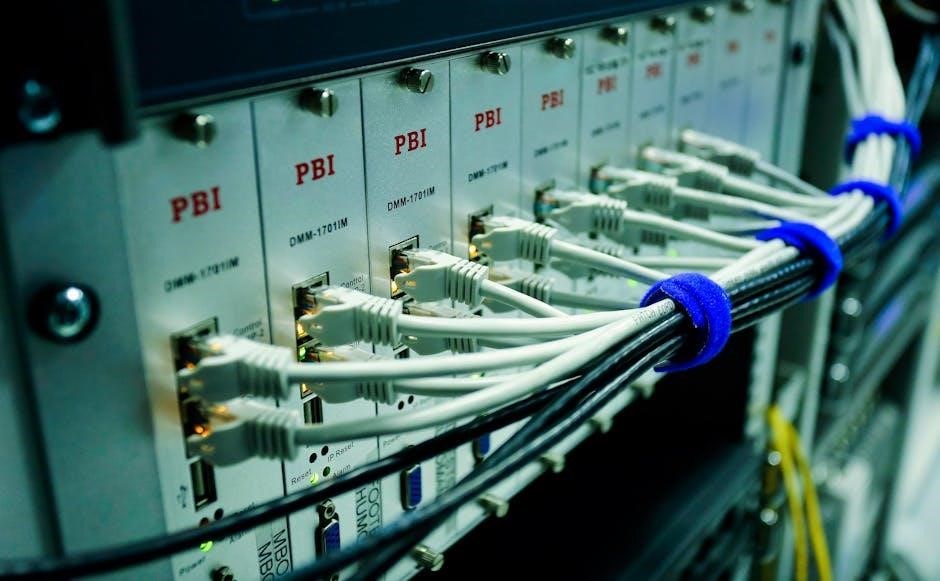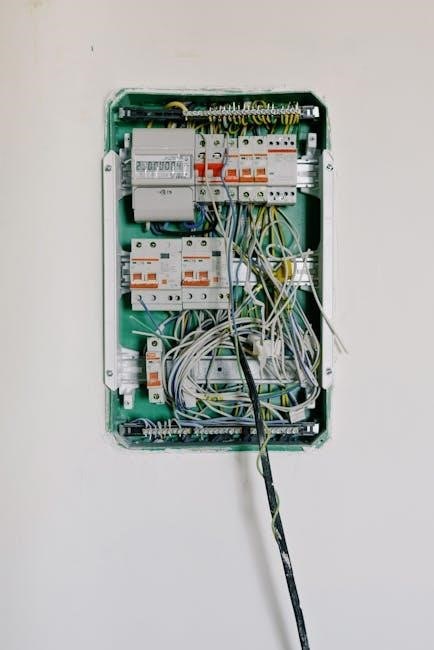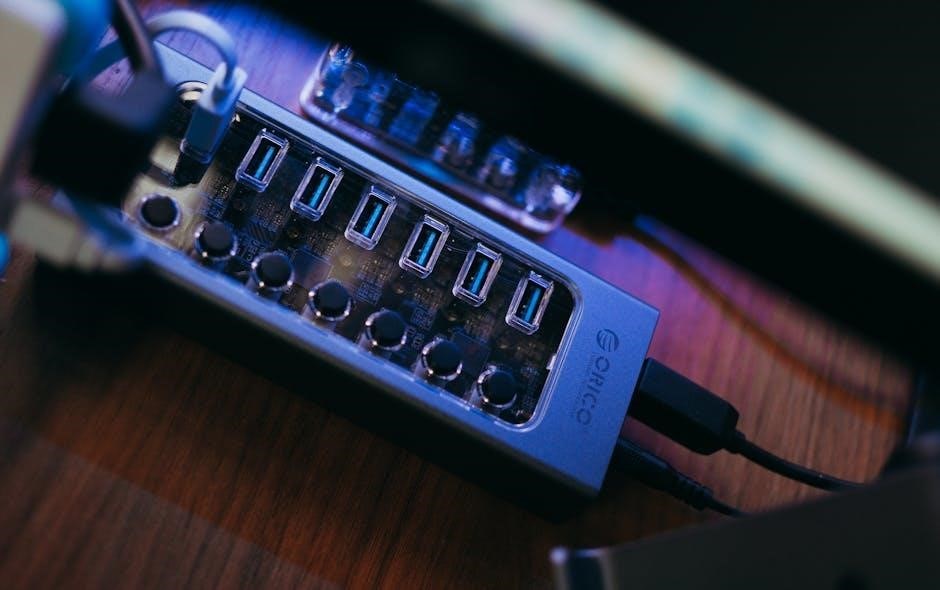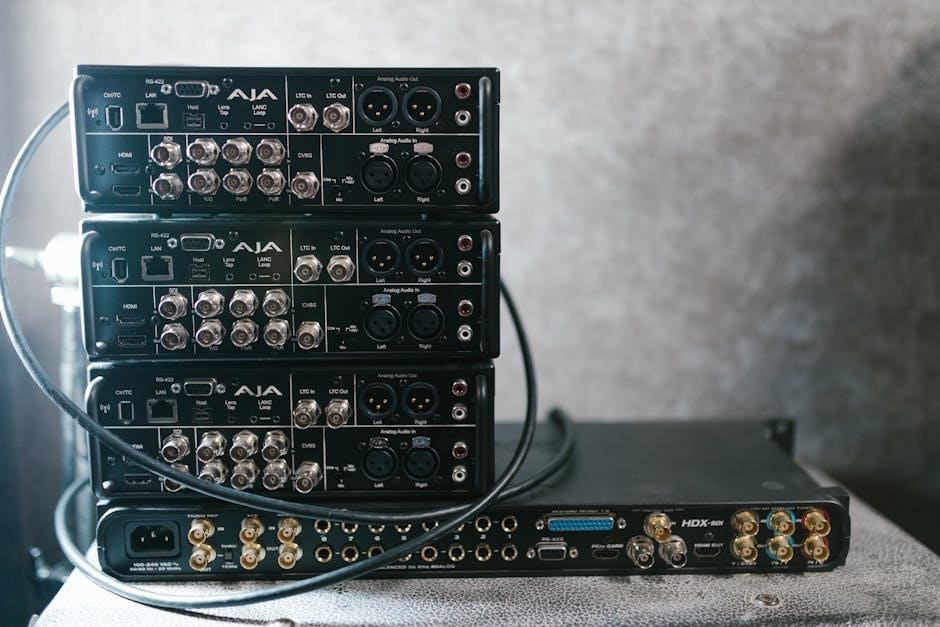Understanding 3-Way Switch Wiring Diagrams
Numerous online resources offer 3-way switch wiring diagram PDFs, simplifying installation and troubleshooting․ Lutron provides detailed manuals, while NEC code compliance guides ensure safety․
These diagrams illustrate connections between power, travelers, and the light fixture, aiding in understanding basic and advanced wiring scenarios for various applications․
Accessing these PDFs empowers DIYers and professionals alike, offering visual aids for successful 3-way switch installations and repairs, promoting electrical proficiency․
Three-way switches offer convenient control of a light fixture from two different locations, enhancing accessibility and functionality within a home or building․ Understanding their operation begins with recognizing the unique wiring configurations required, often best visualized through a 3-way switch wiring diagram PDF․
Unlike standard switches, 3-way switches don’t simply break or complete a single circuit; instead, they redirect the flow of electricity along one of two “traveler” wires․ This allows either switch to turn the light on or off, regardless of the other switch’s position․
Diagrams are crucial for deciphering the common, traveler, and line terminals, ensuring correct connections․ Resources like Lutron manuals and online tutorials provide these diagrams, alongside NEC code guidance, for safe and effective installations․ Mastering this system unlocks enhanced lighting control․
What is a 3-Way Switch?
A 3-way switch is a specialized electrical switch enabling control of a single light fixture from two separate locations․ It differs from a standard switch, which controls a light from only one point․ Visualizing its internal workings is greatly aided by a detailed 3-way switch wiring diagram PDF․
These switches possess three terminals: a common terminal, and two traveler terminals․ The common terminal connects to either one of the traveler terminals, directing power to the light․ This switching action is what allows operation from both locations․
Understanding the internal mechanism is key to successful wiring, and resources like Lutron manuals and online tutorials, often in PDF format, provide clear diagrams․ Correct wiring, guided by these resources, ensures safe and functional lighting control․
Applications of 3-Way Switches
3-way switches are incredibly versatile, commonly used in hallways, staircases, and large rooms where convenient access to lighting control from multiple points is desired․ A 3-way switch wiring diagram PDF is invaluable when planning these installations․
They’re also ideal for bedrooms, allowing control from both the doorway and bedside․ More complex applications include controlling a ceiling fan or multiple lights, requiring careful adherence to wiring diagrams․
Resources like NEC code compliance guides, often available as PDFs, ensure installations meet safety standards․ Understanding these applications, coupled with a clear wiring diagram, empowers both DIYers and professionals to create functional and convenient lighting solutions․

Essential Components for Wiring
A 3-way switch wiring diagram PDF aids in identifying necessary parts: switches, 14/2 or 14/3 wire, connectors, and electrical tape for a safe setup․
3-Way Switches Themselves
Understanding 3-way switches is crucial when referencing a wiring diagram PDF․ Unlike standard switches, these possess three terminals: a common terminal and two traveler terminals․ The common terminal receives power from the source or directs it to the light fixture․ Traveler terminals facilitate the switching action between the two switches․
A 3-way switch wiring diagram PDF clearly illustrates how these terminals connect, showing the flow of electricity․ Identifying these terminals on the physical switch is the first step, often indicated by different screw colors․ Correctly connecting the wires to these terminals, as shown in the diagram, is vital for proper functionality․
Lutron manuals, often available as PDFs, detail specific switch models and their terminal configurations, ensuring compatibility and correct installation․
Electrical Wire Types (14/2, 14/3)
A 3-way switch wiring diagram PDF will specify the necessary wire types, commonly 14/2 and 14/3․ 14/2 wire (Romex) contains a black, white, and ground wire, suitable for standard power delivery․ However, 3-way circuits often require 14/3 wire, which adds a red wire alongside black, white, and ground․
The red wire acts as a traveler, carrying the switching signal between the two 3-way switches․ Diagrams clearly depict how these wires connect to the switch terminals․ Understanding the wire gauge (14) and the number of conductors is vital for safe and code-compliant wiring․
PDF guides from Lutron and NEC resources emphasize using the correct wire type, ensuring circuit integrity and preventing electrical hazards․
Wire Connectors and Electrical Tape
A comprehensive 3-way switch wiring diagram PDF highlights the importance of secure wire connections, typically achieved using wire connectors (wire nuts)․ These connectors join the wires safely and efficiently, preventing loose connections and potential hazards․ Different sizes are needed based on the number and gauge of wires․
Electrical tape serves as a supplementary safety measure, reinforcing connections and insulating exposed wire ends․ Diagrams often show tape being applied to wire nuts for added security․
Lutron manuals and NEC guides emphasize proper connector usage and taping techniques, ensuring a reliable and code-compliant installation․ Always use UL-listed connectors and electrical tape․

Basic 3-Way Switch Wiring Diagram
3-way switch wiring diagram PDFs clearly depict the common, traveler, and line terminals, illustrating power source and load connections for simple control․
These diagrams simplify understanding the circuit, enabling safe and effective installation of 3-way switch setups․
Identifying the Common, Traveler, and Line Terminals
3-way switch wiring diagram PDFs are crucial for correctly identifying terminals․ The common terminal, often darker in color, receives power from the source or connects to the light fixture․
Traveler terminals, typically a pair of brass screws, carry the switched power between the two switches; diagrams clearly show these connections․
The line terminal connects to the power source, and understanding its location is vital for safe wiring․ PDFs highlight these distinctions, often using color-coding․
Carefully studying a diagram ensures proper identification, preventing incorrect wiring and potential hazards․ Lutron manuals and NEC guides reinforce this understanding, providing detailed visual aids for each terminal’s function․
Accurate identification is paramount for a functional and safe 3-way switch circuit․
Power Source Connection (Line)
3-way switch wiring diagram PDFs emphasize the importance of the line connection․ The power source, or “line,” connects to the common terminal of the first 3-way switch․
Diagrams illustrate this connection, typically using black wire for hot and white for neutral, adhering to standard color-coding conventions․
Always disconnect power at the breaker before making any connections, a safety precaution highlighted in most PDFs and NEC guides․
Proper grounding is also crucial, ensuring a safe electrical pathway․ Lutron manuals detail grounding techniques alongside line connection instructions․
Incorrect line connections can cause shorts or malfunctions, so careful adherence to the diagram is essential for a functional and safe circuit․
Load Connection (Light Fixture)
3-way switch wiring diagram PDFs clearly depict the load connection, which is the wire leading to the light fixture․ This connection typically originates from the common terminal of the second 3-way switch․
Diagrams show the load wire, often black, connecting to the hot terminal of the light fixture, while the neutral wire connects to the neutral terminal․
Some diagrams illustrate scenarios where the fixture is between switches and the panel, requiring careful attention to wire swapping for correct operation․
Lutron manuals emphasize secure wire connections to prevent flickering or intermittent operation․ NEC code compliance guides ensure safe fixture wiring practices․
Proper load connection is vital for a functioning circuit, and PDFs provide visual guidance for accurate and safe installation․
Traveler Wire Connections
3-way switch wiring diagram PDFs highlight traveler wire connections, crucial for enabling switching from two locations․ These wires, typically red and another color, connect the two 3-way switches․
Diagrams illustrate that traveler wires connect to the traveler terminals on each switch – these are usually brass-colored screws․ Correct connection is vital for functionality․
Reversed traveler wires can cause the switches to operate inversely, a common issue addressed in troubleshooting guides found within these PDFs․
Lutron manuals emphasize the importance of identifying and correctly connecting travelers, while NEC guides ensure safe wiring practices․
Understanding traveler connections is key to a successful 3-way switch installation, and PDFs provide clear visual instructions․

Advanced Wiring Scenarios
3-way switch wiring diagram PDFs detail complex setups, including multiple lights, fan control, and unique fixture placements, expanding beyond basic configurations․
These resources illustrate wiring for lights between switches and the panel, offering solutions for diverse home electrical layouts and customization options․
3-Way Switch Wiring with Multiple Lights
Wiring multiple lights with 3-way switches requires careful planning and a detailed 3-way switch wiring diagram PDF․ These diagrams illustrate how to connect several light fixtures to a single 3-way circuit, expanding the control to illuminate multiple areas from two locations․
Typically, the lights are wired in parallel, ensuring each receives power simultaneously when either switch is activated․ The PDF diagrams will showcase how to properly connect the traveler wires, common terminals, and the line/load connections to accommodate the additional fixtures․
Understanding the wiring sequence is crucial; incorrect connections can lead to flickering lights or a non-functional circuit․ Resources like Lutron manuals and NEC code guides, often available as PDFs, provide essential insights for safe and compliant installations when dealing with multiple lights․
Wiring a 3-Way Switch with a Light Between Switches and Panel
When a light fixture is positioned between the 3-way switches and the electrical panel, a specific wiring configuration is required, best understood with a detailed 3-way switch wiring diagram PDF․ These diagrams often illustrate switching the white (neutral) and black (hot) wires at the light fixture location․
This configuration allows the power to reach the first switch, travel to the light, and then continue to the second switch, completing the circuit․ The PDF will clearly show how to identify the line, load, and traveler wires in this unique setup․

It’s vital to consult NEC code guidelines and resources like Lutron manuals (available as PDFs) to ensure the wiring adheres to safety standards and functions correctly, preventing potential hazards or malfunctions․
Using a 3-Way Switch to Control a Ceiling Fan
Controlling a ceiling fan with 3-way switches requires careful wiring, best visualized with a dedicated 3-way switch wiring diagram PDF․ These diagrams illustrate how to connect the fan’s motor and light kit to the traveler wires, ensuring both speed and illumination are controllable from two locations․
The PDF will detail how to identify the fan’s hot, neutral, and ground wires, and how to properly connect them to the 3-way switches and the power source․ It’s crucial to understand the fan’s wiring schematic alongside the 3-way switch diagram․
Always consult NEC code and manufacturer’s instructions (often available as PDFs) to guarantee safe and compliant installation, preventing motor damage or electrical hazards․

Troubleshooting Common Issues
3-way switch wiring diagram PDFs aid in diagnosing problems, like lights not turning on or flickering․ They help trace connections and identify reversed traveler wires efficiently․
Switch Doesn’t Turn On the Light
If a 3-way switch fails to illuminate the light, a 3-way switch wiring diagram PDF becomes invaluable․ Begin by verifying power is off at the breaker before inspecting connections․ Carefully review the diagram to ensure the common wire is correctly connected to the power source (line) and the load (light fixture)․
Check all wire connections within the switch boxes and at the light fixture itself, ensuring they are secure and properly tightened․ A loose connection is a frequent culprit․ Utilize the PDF to confirm traveler wires are connected to the traveler terminals on both switches․ Incorrect traveler wiring prevents proper circuit completion․
Finally, confirm the light bulb is functional․ A blown bulb can mimic a wiring issue․ Referencing the diagram helps systematically eliminate potential causes, leading to a swift resolution․ Remember safety first – always disconnect power before troubleshooting!
Light Flickers or Doesn’t Stay On
A flickering or intermittently functioning light controlled by 3-way switches often indicates a loose connection․ A 3-way switch wiring diagram PDF is crucial for systematic troubleshooting․ Begin by safely disconnecting power at the breaker․ Inspect all wire connections within both switch boxes and at the light fixture, tightening any that are loose․
Refer to the PDF diagram to verify the correct wiring configuration, paying close attention to traveler wire connections․ Reversed traveler wires can cause erratic behavior․ Ensure the common wire is securely connected to the power source and load․ A faulty switch can also cause flickering; consider replacing it․
If the issue persists, carefully examine wire connectors for damage or corrosion․ Properly secured connections are vital for stable operation․ Always prioritize safety and consult a qualified electrician if unsure․
Identifying Reversed Traveler Wires
Reversed traveler wires are a common issue in 3-way switch circuits, causing the switches to operate incorrectly․ A detailed 3-way switch wiring diagram PDF is invaluable for diagnosis․ If the light doesn’t respond as expected when toggling either switch, suspect reversed travelers․
The diagram will show which wires are designated as travelers – typically, but not always, red and another color․ Swap the connections of these two wires at both switch locations․ Test the switches after each swap․ If the light now functions correctly, the travelers were indeed reversed․
Carefully follow the PDF’s color coding and terminal markings․ Incorrect traveler wiring doesn’t pose a safety hazard, but it will prevent proper circuit operation․ Always disconnect power before making any wiring changes․

Safety Precautions
Always consult a 3-way switch wiring diagram PDF before starting․ Turn off power at the breaker and use a non-contact tester to confirm it’s off!
Turning Off Power at the Breaker
Before referencing any 3-way switch wiring diagram PDF and commencing work, absolutely prioritize safety by completely disconnecting the power supply․ Locate the electrical panel and identify the circuit breaker controlling the 3-way switch you’ll be working on․
Flip the breaker to the “OFF” position․ Do not assume this is sufficient; always verify the power is truly off․ A non-contact voltage tester is crucial for this step․ Carefully test the wires at the switch location to ensure no voltage is present․
Double-check – even after testing – to avoid accidental shock․ Working with electricity can be dangerous, and a 3-way switch wiring diagram PDF is useless if safety isn’t paramount․ Treat every wire as if it’s live until proven otherwise․
Using a Non-Contact Voltage Tester
Even with a 3-way switch wiring diagram PDF in hand, safety remains paramount․ A non-contact voltage tester is an essential tool for verifying power is off before handling any wires․ These testers detect the presence of voltage without physical contact, offering a crucial layer of protection․
Slowly pass the tester’s tip near each wire at the switch location after turning off the breaker․ If the tester lights up or beeps, voltage is still present – do not proceed! Re-check the breaker panel and ensure the correct breaker is switched off․

Test all wires, including the ground, to confirm a complete power disconnect․ This simple step, guided by your wiring diagram PDF, can prevent serious electrical shock and ensure a safe working environment․
Proper Grounding Techniques
Referencing your 3-way switch wiring diagram PDF, always prioritize proper grounding․ Grounding provides a safe path for electrical current in case of a fault, preventing shocks and fires․ Typically, grounding wires are bare copper or green․
Connect the grounding wire from the circuit to the grounding screw on the metal switch box and to the grounding terminal on the 3-way switch itself․ Ensure a secure connection – a loose ground is as dangerous as no ground at all․
If using a plastic switch box, connect the grounding wire to a grounding pigtail extending to the metal box or a grounding screw installed in the box․

Reading and Interpreting Wiring Diagrams
3-way switch wiring diagram PDFs utilize symbols and color coding for clarity․ Understanding these conventions is crucial for accurate installation and safe electrical work․
Locate diagrams online to decipher connections and ensure proper wiring before commencing any electrical project․
Understanding Symbols Used in Diagrams
3-way switch wiring diagram PDFs rely on standardized symbols to represent electrical components․ Recognizing these is fundamental to interpreting the diagram correctly․ A simple line often denotes a conductor, while circles represent switches, and variations signify different switch types․
The common terminal is frequently depicted with a shaded or distinct marking, differentiating it from traveler terminals․ Traveler terminals are usually shown as parallel lines․ Understanding these visual cues is vital for tracing the circuit’s path․
Grounding symbols, typically represented by a series of downward-pointing lines or a triangle, indicate the grounding connections essential for safety․ Familiarizing yourself with these symbols, found within the PDF, ensures accurate wiring and minimizes the risk of electrical hazards․
Following Color Coding Conventions
3-way switch wiring diagram PDFs consistently employ color coding to simplify identification of wires․ Black wires typically represent hot (live) conductors, while white wires signify neutral returns․ Green or bare copper wires are universally used for grounding, ensuring electrical safety․
Traveler wires, crucial in 3-way switch circuits, are often depicted as red or another color distinct from hot and neutral․ Adhering to these conventions, as shown in the PDF, minimizes confusion during installation and troubleshooting․
Always verify wire colors with a non-contact voltage tester before making connections․ Deviations from standard color coding can indicate pre-existing wiring issues, requiring careful assessment before proceeding․ Consistent color adherence is key to a safe and functional circuit․
Locating PDF Wiring Diagrams Online
Numerous websites offer free 3-way switch wiring diagram PDFs, catering to diverse skill levels․ Lutron’s official website provides comprehensive manuals for their switches, detailing wiring configurations․ Electrical forums and DIY enthusiast sites frequently host user-submitted diagrams․
A simple Google search for “3-way switch wiring diagram PDF” yields a wealth of results, including diagrams for various scenarios like multiple lights or fan control․ Reputable electrical supply retailers also often provide downloadable PDFs․
Always prioritize diagrams from trusted sources and cross-reference them to ensure accuracy before commencing any electrical work․ Downloading and saving these PDFs provides a convenient reference during installation․

Resources and Further Learning
Explore Lutron’s manuals and NEC code guides for detailed 3-way switch wiring information․ Online video tutorials and downloadable PDFs enhance understanding․
These resources provide comprehensive knowledge, aiding in safe and compliant installations, furthering your electrical expertise with practical guidance․
Lutron 3-Way Switch Wiring Manuals
Lutron offers extensive wiring manuals, often available as downloadable PDF documents, specifically tailored to their 3-way switch products․ These manuals are invaluable resources for both novice and experienced users, providing clear, step-by-step instructions and detailed 3-way switch wiring diagrams․
They cover a range of scenarios, from basic installations to more complex configurations, ensuring compatibility and optimal performance․ Lutron’s documentation emphasizes safety, outlining crucial precautions and adhering to National Electrical Code (NEC) standards․
The PDFs typically include troubleshooting guides to assist with common issues, such as switches not functioning correctly or lights flickering․ Accessing these manuals directly from Lutron’s website guarantees the most up-to-date and accurate information for your specific model, promoting a successful and safe installation process․
NEC Code Compliance for 3-Way Switch Wiring
Adhering to the National Electrical Code (NEC) is paramount when wiring 3-way switches, and 3-way switch wiring diagram PDFs often incorporate these standards․ NEC guidelines dictate proper grounding techniques, wire gauge requirements, and safe installation practices to prevent electrical hazards․
Compliance ensures the safety of occupants and the longevity of the electrical system․ Key NEC considerations include using appropriate wire connectors, ensuring proper box fill capacity, and correctly identifying neutral and ground wires․
Consulting NEC-compliant diagrams and resources is crucial, as local codes may have additional requirements․ Ignoring NEC standards can lead to fines, insurance issues, and, most importantly, dangerous electrical conditions․ Always prioritize safety and code adherence during any electrical work․
Online Video Tutorials on 3-Way Switch Wiring
Numerous online video tutorials complement 3-way switch wiring diagram PDFs, offering a dynamic learning experience․ These videos visually demonstrate wiring processes, clarifying complex concepts for both beginners and experienced DIYers․
Many tutorials break down wiring into step-by-step instructions, covering common scenarios like wiring with multiple lights or a fixture between the switch and panel․ They often highlight potential pitfalls and troubleshooting tips․
Searching platforms like YouTube reveals a wealth of resources, including videos detailing line vs․ load connections and traveler wire identification․ Combining video guidance with a 3-way switch wiring diagram PDF ensures a comprehensive understanding and successful installation․
